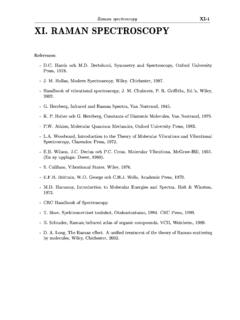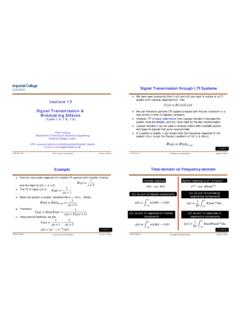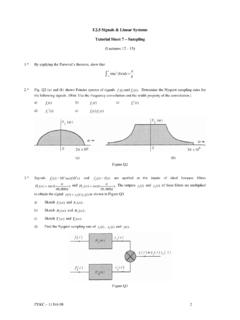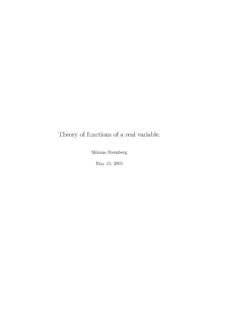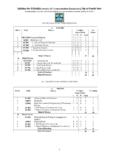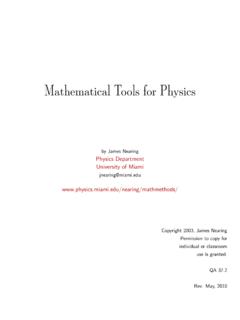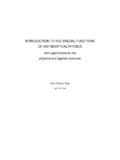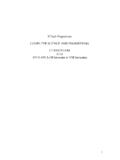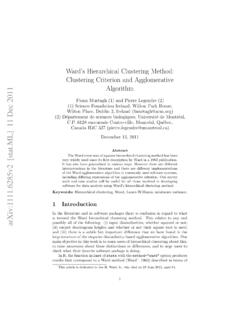Transcription of Chapter 2 Signal and system norms - Åbo Akademi
1 Chapter 2. Signal and system norms A quantitative treatment of the performance and robustness of control systems requires the introduction of appropriate Signal and system norms , which give measures of the magnitudes of the involved signals and system operators. In this Chapter we give a brief description of the most important norms for signals and systems which are useful in optimal and robust control. Signal norms The L2 norm For a scalar-valued Signal v(t) de ned for t 0 the L2- norm is de ned as the square root of the integral of v(t)2, Z. 1 1=2. kvk2 = 0. v(t)2dt ( ). A physical interpretation of the L2 norm is that if v(t) represents a voltage or a current, then kvk22 is proportional to the total energy associated with the Signal . Recall the Laplace-transform, Z 1. v^(s) = 0. v(t)e,stdt ( ). In analogy with ( ), we can de ne an L2- norm for the Laplace-transformed Signal v^(s) on the imaginary axis according to 1=2.
2 Kv^k2 = 21 . Z 1. ,1. j ^(j!)j2d! v ( ). where the factor 1=(2 ) has been introduced for convenience. By Parseval's theorem, the time-domain and frequency-domain L2 - norms ( ) and ( ) are equal, kvk2 = kv^k2 ( ). 9. For a vector-valued Signal v(t) = [v1 (t); : : : ; vm(t)]T , the L2 norm generalizes in a natural way to m 1=2. ! Z m 1X !1=2 Z. 1 1=2. kvk2 = kvik22 v (t)2 dt v(t)T v(t)dt X. = i = ( ). i=1 0 i=1 0. and, similarly for the Laplace-domain Signal v^(s) = [^v1 (s); : : : ; v^m(s)]T , m ! 1=2. kv^k2 = kv^ik22. X. i=1. Z 1 m 1=2 ! 1. = 2 . X. jv^i(j!)j dt 2. ,1 i=1. !1=2. Z 1 m 1. = 2 . X. v^i(,j!)^vi(j!)dt ,1 i=1. 1=2.. 1. = 2 . Z 1. v^(,j!) v^(j!)dt T ( ). ,1. The Lp norms The L2 - norm is a special case of the Lp- norms , de ned as Z. 1 1=p kvkp = 0. jv(t)jpdt ; p 1 ( ). In particular, the L1 - norm is the integral of the absolute value, Z 1.
3 Kvk1 = 0. jv(t)jdt ( ). The Lp- norms can be de ned in the Laplace domain in analogy with ( ), but for p 6= 2, no relation corresponding to Parseval's theorem exists between the time-domain and s-domain norms . Remark The notation L in Lp refers to the fact that the integrand in ( ) should be Lebesgue-integrable for the integral to exist. This is a generalization of the standard (Riemann) integral to a more general class of functions. Remark Function which have a bounded Lp norm belong to the linear space Lp. It is sometimes important to distinguish whether the norm is de ned on the positive real axis R+. or on the imaginary axis jR. Thus, the function v(t) in ( ) belongs to the Lebesgue space L2 (R+ ), and the function v^(s) in ( ) belongs to the Lebesgue space L2(jR). The 1- norm As p ! 1, the Lp norm tends to the so-called 1- norm , or L1 norm , which can be characterized as kvk1 = max t jv(t)j ( ).
4 10. supposing that the maximum exists. However, there is in general no guarantee that the maximum in ( ) exists, and therefore the correct way is to de ne the L1 norm as the least upper bound (or supremum) of the absolute value, kvk1 = sup jv(t)j t ( ). Example The function f (x) = x;.. if jxj < 1 ( ). 0; if jxj 1. has no maximum, because for any x = x1 , x1 = 1 , say (where > 0), one can select another value x2 , such that f (x2 ) > f (x1 ) (take for example x2 = 1 , =2). Therefore, one instead introduces the least upper bound or supremum de ned as the least number M which satis es M f (x) for all x, , sup f (x) = minfM : f (x) M; all xg ( ). x For the function in ( ), supx f (x) = 1. Notice that the minimum in ( ) exists. The greatest lower bound or in mum is de ned in an analogous way. The function in ( ) does not have a minimum, but its greatest lower bound is inf x f (x) = ,1.
5 Remark A more correct way would be to write the L1- norm as kvk1 = ess supt jv(t)j ( ). indicating that points of measure zero ( , isolated points) are excluded when taking the supremum or maximum. However, the functions normally treated in this course are continu- ous, and therefore we will use the de nitions ( ) or ( ). system norms The H2 norm For a stable SISO linear system with transfer function G(s), the H2- norm is de ned in analogy with ( ) as 1=2. 1 Z 1. kGk2 = 2 ,1 jG(j!)j d! 2 (SISO) ( ). For a multivariable system with transfer function matrix G(s) = [gkl(s)], the de nition generalizes to !1=2. kGk2 = kgklk22. X. kl !1=2. = 1 Z 1. X. jg (j!)j2d! 2 ,1 kl kl 11. 1=2 ! = 2 1 Z 1. X. gkl(,j!)gkl(j!)d! ,1 kl 1=2.. = 2 1 Z 1. tr[G(,j!) G(j!)]d! T ( ). ,1. In the last equality, we have used the result ( ) below. Problem Show that for n m matrices A = [akl ] and B = [bkl ], n m tr[AT B ] = akl bkl = a11 b11 + + anm bnm XX.
6 ( ). k=1 l=1. Notice in particular that in the case A = B , equation ( ) gives the sum of the squares of the elements of a matrix, n m tr[AT A] = a2kl = a211 + + a2nm XX. ( ). k=1 l=1. Remark The notation H in H2 (instead of L) is due to the fact that the function spaces which, in addition to having nite Lp norms on the imaginary axis (cf. equation ( )), are bounded and analytic functions in the right-half plane ( with no poles in the RHP), are called Hardy spaces Hp. Thus, stable transfer functions belong to these spaces, provided the associated integral is nite. The spaces are called after the British pure mathematician G. H. Hardy (1877{1947). State-space computation of the H2 norm Rather than evaluating the integrals in ( ) or ( ) directly, the H2 norm of a transfer function is conveniently calculated in the time-domain. In particular, assume that the stable transfer function G(s) has state-space representation x_ (t) = Ax(t) + Bv(t).}
7 Z(t) = Cx(t) ( ). so that G(s) = C (sI , A),1 B ( ). Integrating ( ) from 0 to t gives for z(t), Z t z(t) = CeAt x(0) + 0. H (t , )v( )d ( ). where H (t , ) is the impulse response function de ned as A B; if 0. H ( ) = Ce . 0; if < 0 ( ). Problem Verify ( ). 12. It is straightforward to show that G(s) is simply the Laplace-transform of the impulse response function H ( ), Z 1. G(s) = 0. H ( )e,s d ( ). Problem Verify ( ). From Parseval's theorem applied to H (t) and its Laplace transform G(s) it then follows that kG2k equals the corresponding time-domain norm of the impulse response function H , kGk2 = kH k2 ( ). where Z 1. !1=2 1=2. 2. Z. 1. kH k2 = hkl (t) dt = tr[H (t)T H (t)]dt X. ( ). 0 kl 0. Notice that kH k2 is nite if the system is stable, , all eigenvalues of the matrix A. have strictly negative real parts. By ( ), we can evaluate the H2 norm in ( ) by computing the time-domain norm in ( ).
8 From ( ) and ( ) we have Z 1. kGk2 = kH k2 = tr[C 0 eAt BB T eAT tdtC T ]. 2 2 ( ). De ning the matrix Z 1 At T AT t P= 0. e BB e dt ( ). equation ( ) can be written kH k22 = tr[CPC T ] ( ). It turns out that the matrix P is the unique solution to the linear matrix equation AP + PAT + BB T = 0 ( ). Equation ( ) is known as a matrix Lyapunov equation, due to the fact that it is associated with Lyapunov stability theory of linear systems. The fact that P is the solution to ( ) can be shown by observing that d eAt BB T eAT t = AeAt BB T eAT t + eAtBB T eAT t AT ( ). dt and integrating both sides from 0 to 1. The left-hand side gives Z. d eAtBB T eAT t dt = eAt BB T eAT t 1 = ,BB T. 1 ( ). 0 dt 0. where the fact has been used that exp(At), due to stability, converges to zero as t ! 1. On the right-hand side of ( ) the de nition of P gives Z 1. [AeAt BB T eAT t + eAt BB T eAT t AT ]dt = AP + PAT ( ).
9 0. 13. and thus ( ) follows. There are e cient numerical methods for solving the linear matrix equation ( ). In MATLABs control toolboxes ( ) can be solved using the routine lyap. Signal interpretations of the H2 norm It is useful to interpret the H2 norm de ned for a system transfer function in terms of the input and output signals of the system . Consider the linear system z^(s) = G(s)^v(s) ( ). Assuming a SISO system , suppose that the input has the transform v^(s) = 1 ( ). implying that it contains equal amounts of all frequencies (because v^(j!) = 1). Then the output has the transform z^(s) = G(s) ( ). and according to ( ), its L2 norm equals 1=2. kz^k2 = 21 . Z 1. ,1. j G (j!)j2d! = kGk2 ( ). Hence kGk2 can be interpreted as an average system gain taken over all frequencies. The above result is generalized to the MIMO case by considering the e ect of one input at a time.
10 Let the kth input have a constant Laplace transform equal to one, while the other inputs are zero. Then v^(s) can be written as v^(s) = ek ( ). where ek denotes the kth unit vector, ek = [0 0 1 0 0]T ( ). where the 1 is in the kth position. With this input, the output is Z (s) = G(s)ek and the square of its L2 norm is given by kz^k22 = kGek k22. = 2 1 Z 1. e T G(,j! )T G(j! )e d! k ,1 k = 1. Z 1. tr[G(,j!)ek eTk G(j!)T ]d! ( ). 2 ,1. where we have used the identity tr[AB ] = tr[AT B T ] ( ). 14. Now let each of the inputs in turn have constant Laplace transform, and form the sum of the squares of the L2 norms of the resulting outputs. This gives m Xh i m kz^k22 : v^(s) = ek = kGek k22. X. k=1 k=1. m Z1. = 21 tr[G(,j!)ek eTk G(j!)T ]d! X. k=1 ,1. m = 21 . Z 1. tr[G(,j!) (ek eTk )G(j!)T ]d! X. ,1 k=1. = 1 Z 1. tr[G(,j!)IG(j!)T ]d! 2 Z,1. = 21 . 1. tr[G(,j!)]
